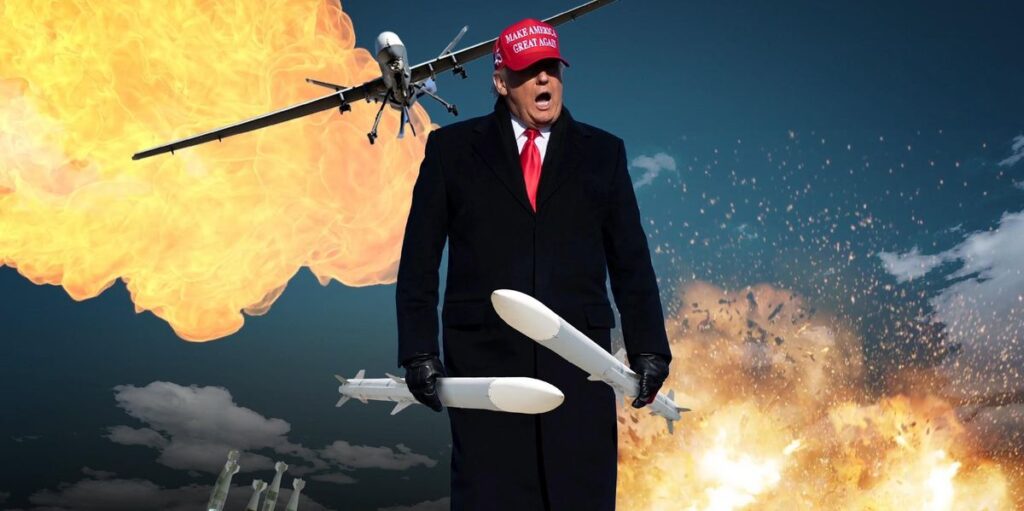During Donald Trump’s presidency, he was characterized by actions that consistently escalated global tensions. His administration expedited military support to Saudi Arabia and the United Arab Emirates amid the humanitarian crisis unfolding in Yemen, flirted dangerously with nuclear confrontation with North Korea, exacerbated U.S.-Iran relations, and schemed for regime change in Venezuela. Trump’s presidency also saw significant military spending increases. Post-presidency, Trump has continued to endorse violent actions overseas, expressing admiration for Russia’s invasion of Ukraine and encouraging Israel’s aggressive military operations in Gaza and Lebanon. Ironically, as he seeks a second term, Trump attempts to present himself as a candidate for global peace, proclaiming a desire for “peace on earth,” while concurrently accusing his political opponents of being the real warmongers.
Trump’s foreign policy messaging taps into a dual narrative of hope and fear. He positions himself as an agent of change who would ameliorate ongoing conflicts, contrasting sharply with Vice President Kamala Harris, whom he claims would lead the U.S. into World War III due to her alleged incompetence. This self-characterization as a peacemaker is starkly at odds with his violent rhetoric and past actions, and some observers worry that this portrayal could mislead voters. His campaign suggests that, disillusioned with current U.S. foreign policy under President Biden—particularly his support for Israel—voters might be tempted to believe that Trump represents a more tranquil future. As he reflects on his tenure as a negotiator, Trump has expressed dissatisfaction with the financial burdens of military engagements and has drawn attention to the detrimental effects of visual media on global perceptions, signaling a potential dual desire for both historical recognition and normalized diplomatic relations.
Supporters of Trump hypothesize that a more stable world aligns with his personal and economic interests, particularly given his financial investments in the Middle East. The former president’s close ties with Saudi Arabia and others suggest a motivation that extends beyond mere diplomacy. However, critics contend that Trump’s brash style could provoke conflict rather than prevent it. Many analysts believe that while luck and fortuitous restraint from adversarial nations helped the U.S. avoid major conflicts during his administration, the long-term consequences of his policies have been damaging. The circumstances surrounding the chaotic withdrawal from Afghanistan and the escalation of unrest fueled by his administration’s decisions continue to reverberate. Trump’s approach appears to lean towards greater confrontation rather than the humility needed for effective diplomacy, leading to skepticism about a potential second term ushering in stability.
The prospect of further conflict and suffering looms large with the actions Trump has previously endorsed. His reticence toward addressing middle-ground diplomacy signals a troubling future for many global hotspots. Despite the Biden administration’s failures to broker peace initiatives, particularly in Gaza, there is little indication that Trump would champion a balanced resolution. His long alignment with hardline Israeli policies raises concerns that his presidency could exacerbate violence rather than alleviate it. Indeed, any negotiations regarding Gaza will face the prospect of ongoing aggression, as Trump’s administration would likely favor Israeli interests over a fair resolution for Palestinians—given past success rates of his peacemaking endeavors, skepticism remains high among advocacy groups.
In the case of U.S.-Iran relations, Trump’s past approach has only heightened tensions and solidified enmity, especially following his withdrawal from the Iran nuclear deal. With Iran reportedly closer to nuclear capability, the conditions for a more severe confrontation heighten. While Trump hints at a willingness to negotiate, he must navigate complex geopolitical waters successfully—a significant risk factor should he return to power. Experts warn that the lack of careful diplomacy could inadvertently lead to greater military confrontation, especially in the aftermath of recent hostilities between Israel and Iranian-backed groups.
The issues surrounding Ukraine illustrate the broader implications of a potential Trump return to the White House. With Trump portraying Biden’s support for Ukraine as excessive and unsustainable, a ceasefire and a more conciliatory approach toward Russia could emerge as potential cornerstones of a Trump administration’s approach to the conflict. However, experts caution that without addressing core issues of sovereignty and territorial integrity, any settlement could merely serve as a transient truce rather than a lasting peace. On the European front, fears of Trump’s skepticism toward NATO could encourage further Russian aggression, complicating efforts to deter emergent global threats.
Looking ahead, a potential second Trump presidency raises alarms on multiple fronts regarding foreign policy oversight and strategy. His association with the Project 2025 blueprint, which calls for a significant downsizing of the State Department and challenges to established diplomatic norms, could dismantle essential mechanisms for crisis management. Furthermore, Trump’s history of resisting congressional restraint on military actions suggests that he would potentially veer toward unilateral decision-making in international relations. This reality raises significant concerns about the efficacy of preventative measures against impending conflicts and the broader implications for global peace initiatives under his leadership. Overall, the likelihood of Trump continuing to embody a peace-oriented stance appears tenuous at best, leaving many observers profoundly skeptical about the prospects for U.S. foreign policy stability under his governance.

